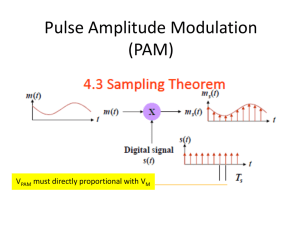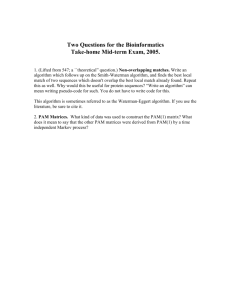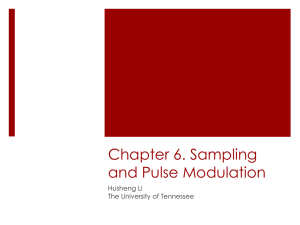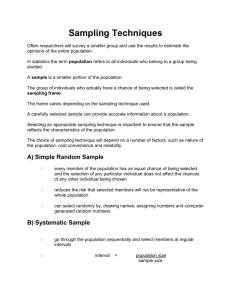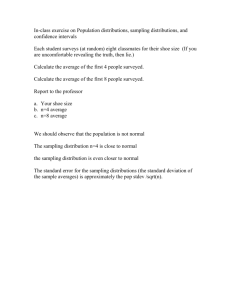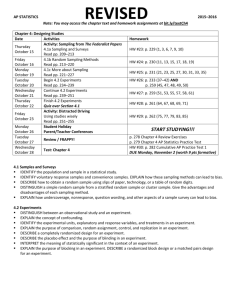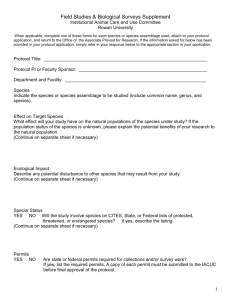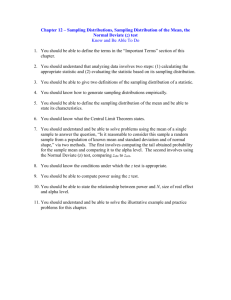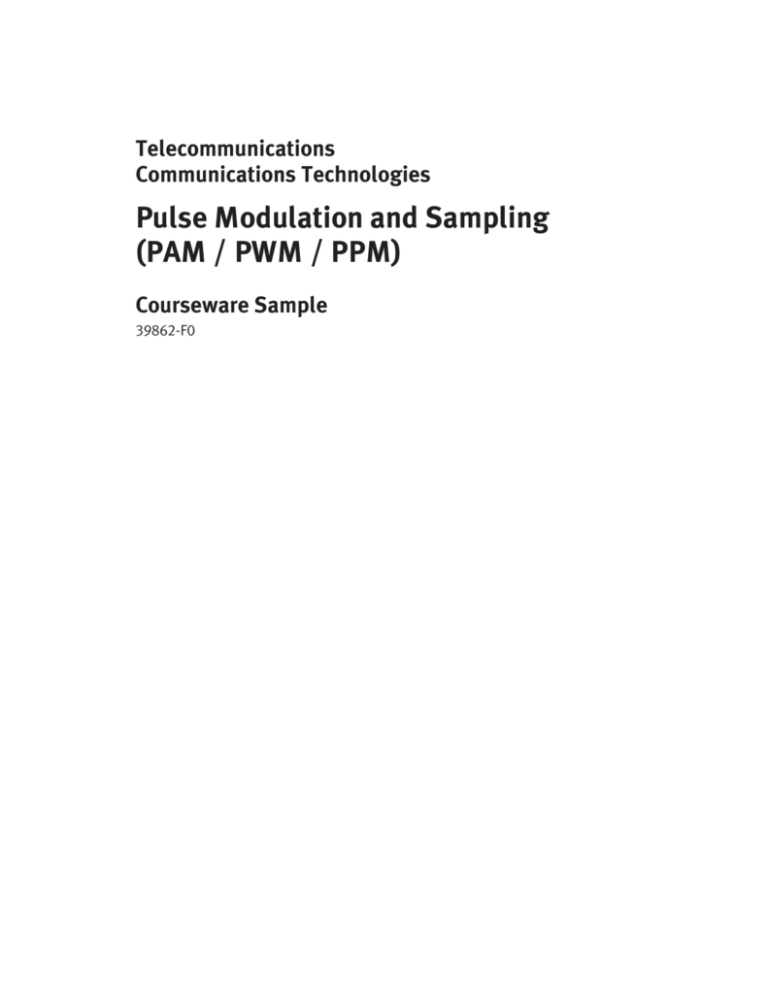
Telecommunications
Communications Technologies
Pulse Modulation and Sampling
(PAM / PWM / PPM)
Courseware Sample
39862-F0
Order no.:
39862-10
First Edition
Revision level: 04/2015
By the staff of Festo Didactic
© Festo Didactic Ltée/Ltd, Quebec, Canada 2007
Internet: www.festo-didactic.com
e-mail: did@de.festo.com
Printed in Canada
All rights reserved
ISBN 978-2-89640-233-5 (Printed version)
Legal Deposit – Bibliothèque et Archives nationales du Québec, 2007
Legal Deposit – Library and Archives Canada, 2007
The purchaser shall receive a single right of use which is non-exclusive, non-time-limited and limited
geographically to use at the purchaser's site/location as follows.
The purchaser shall be entitled to use the work to train his/her staff at the purchaser's site/location and
shall also be entitled to use parts of the copyright material as the basis for the production of his/her own
training documentation for the training of his/her staff at the purchaser's site/location with
acknowledgement of source and to make copies for this purpose. In the case of schools/technical
colleges, training centers, and universities, the right of use shall also include use by school and college
students and trainees at the purchaser's site/location for teaching purposes.
The right of use shall in all cases exclude the right to publish the copyright material or to make this
available for use on intranet, Internet and LMS platforms and databases such as Moodle, which allow
access by a wide variety of users, including those outside of the purchaser's site/location.
Entitlement to other rights relating to reproductions, copies, adaptations, translations, microfilming and
transfer to and storage and processing in electronic systems, no matter whether in whole or in part, shall
require the prior consent of Festo Didactic GmbH & Co. KG.
Information in this document is subject to change without notice and does not represent a commitment on
the part of Festo Didactic. The Festo materials described in this document are furnished under a license
agreement or a nondisclosure agreement.
Festo Didactic recognizes product names as trademarks or registered trademarks of their respective
holders.
All other trademarks are the property of their respective owners. Other trademarks and trade names may
be used in this document to refer to either the entity claiming the marks and names or their products.
Festo Didactic disclaims any proprietary interest in trademarks and trade names other than its own.
Safety and Common Symbols
The following safety and common symbols may be used in this manual and on
the equipment:
Symbol
Description
DANGER indicates a hazard with a high level of risk which, if not
avoided, will result in death or serious injury.
WARNING indicates a hazard with a medium level of risk which,
if not avoided, could result in death or serious injury.
CAUTION indicates a hazard with a low level of risk which, if not
avoided, could result in minor or moderate injury.
CAUTION used without the Caution, risk of danger sign ,
indicates a hazard with a potentially hazardous situation which,
if not avoided, may result in property damage.
Caution, risk of electric shock
Caution, hot surface
Caution, risk of danger
Caution, lifting hazard
Caution, hand entanglement hazard
Notice, non-ionizing radiation
Direct current
Alternating current
Both direct and alternating current
Three-phase alternating current
Earth (ground) terminal
© Festo Didactic 39862-10
III
Safety and Common Symbols
Symbol
Description
Protective conductor terminal
Frame or chassis terminal
Equipotentiality
On (supply)
Off (supply)
Equipment protected throughout by double insulation or
reinforced insulation
In position of a bi-stable push control
Out position of a bi-stable push control
IV
© Festo Didactic 39862-10
Table of Contents
Preface .................................................................................................................. XI
Acknowledgements ............................................................................................. XIII
About This Manual .............................................................................................. XV
Conventions Used in This Manual .................................................................... XVII
List of Equipment Required ................................................................................ XIX
To the Instructor ................................................................................................. XXI
Unit 1
Pulses ............................................................................................. 1
DISCUSSION OF FUNDAMENTALS......................................................... 1
Pulses ....................................................................................... 1
Fourier analysis ......................................................................... 2
Time and frequency domain representations ........................... 2
Band-limiting and noise ............................................................. 3
Ex. 1-1
Time Characteristics of Pulses .................................................... 5
DISCUSSION ...................................................................................... 5
Rectangular pulses ................................................................... 5
Pulse characteristics ................................................................. 5
PROCEDURE ...................................................................................... 7
Set-up and connections ............................................................ 7
Observing pulses ...................................................................... 8
Filtering ................................................................................... 11
Ex. 1-2
Frequency Characteristics of Pulses ........................................ 17
DISCUSSION .................................................................................... 17
Frequency components .......................................................... 17
Fourier analysis ....................................................................... 19
Signal envelope....................................................................... 21
PROCEDURE .................................................................................... 21
Set-up and connections .......................................................... 21
Observing pulse signals .......................................................... 22
Observing a pulse frequency spectrum .................................. 23
Ex. 1-3
Band-Limiting............................................................................... 31
DISCUSSION .................................................................................... 31
Spectral analysis ..................................................................... 31
All-pass filter............................................................................ 32
Ideal low-pass filter ................................................................. 32
Practical low-pass filter ........................................................... 33
Cutoff frequency ...................................................................... 33
Filtering effects ........................................................................ 33
© Festo Didactic 39862-10
V
Table of Contents
PROCEDURE .................................................................................... 34
Set-up and connections .......................................................... 34
Observing a pulse signal ......................................................... 35
Observing a pulse frequency spectrum .................................. 35
Filtering in the frequency domain ............................................ 36
Rise time ................................................................................. 41
Unit 2
Pulse Amplitude Modulation (PAM) ........................................... 53
DISCUSSION OF FUNDAMENTALS....................................................... 53
Pulse modulation..................................................................... 53
Nyquist rate ............................................................................. 53
Ex. 2-1
PAM Signals ................................................................................. 55
DISCUSSION .................................................................................... 55
Signal sampling ....................................................................... 55
PAM signal generation ............................................................ 56
Sampling rate .......................................................................... 57
PROCEDURE .................................................................................... 58
Set-up and connections .......................................................... 58
Sampling rates ........................................................................ 58
Sampling modes and pulse width ........................................... 62
Ex. 2-2
Spectral Characteristics of PAM Signals .................................. 65
DISCUSSION .................................................................................... 65
Sampling ................................................................................. 65
Aperture distortion ................................................................... 67
PROCEDURE .................................................................................... 68
Set-up and connections .......................................................... 68
Input signal spectrum .............................................................. 69
PAM signal spectrum .............................................................. 70
Harmonics and replicas........................................................... 74
Ex. 2-3
Aliasing and the Nyquist Rate .................................................... 81
DISCUSSION .................................................................................... 81
Sampling rate .......................................................................... 81
Sampling Theorem .................................................................. 83
PROCEDURE .................................................................................... 85
Set-up and connections .......................................................... 85
Nyquist sampling rate – time domain ...................................... 85
Nyquist sampling rate – frequency domain ............................. 90
VI
© Festo Didactic 39862-10
Table of Contents
Ex. 2-4
Pre-filtering................................................................................... 95
DISCUSSION .................................................................................... 95
Pre-filtering .............................................................................. 95
Practical limitations ................................................................. 95
PROCEDURE .................................................................................... 96
Set-up and connections .......................................................... 96
Pre-filtering .............................................................................. 97
Dual input signals .................................................................... 99
Unit 3
Demodulating PAM Signals ...................................................... 109
DISCUSSION OF FUNDAMENTALS..................................................... 109
PAM demodulation ................................................................ 109
Requirements for demodulation ............................................ 109
Ex. 3-1
PAM Signals Demodulation ...................................................... 111
DISCUSSION .................................................................................. 111
Filtering ................................................................................. 111
Aperture distortion ................................................................. 113
PROCEDURE .................................................................................. 114
Set-up and connections ........................................................ 114
PAM demodulation in the time domain ................................. 115
PAM demodulation in the frequency domain ........................ 119
Ex. 3-2
Aliasing ....................................................................................... 125
DISCUSSION .................................................................................. 125
Nyquist rate ........................................................................... 125
Aliasing .................................................................................. 126
PROCEDURE .................................................................................. 127
Set-up and connections ........................................................ 127
PAM demodulation in the time domain ................................. 127
PAM demodulation in the frequency domain ........................ 130
Unit 4
Pulse-Time Modulation (PWM / PPM) ...................................... 141
DISCUSSION OF FUNDAMENTALS..................................................... 141
PWM/PPM modulation ......................................................... 141
PWM/PPM demodulation ..................................................... 143
Ex. 4-1
PWM and PPM Signal Modulation............................................ 145
DISCUSSION .................................................................................. 145
PWM/PPM generation.......................................................... 145
Dynamic range ...................................................................... 146
© Festo Didactic 39862-10
VII
Table of Contents
PROCEDURE .................................................................................. 148
Set-up and connections ........................................................ 148
PWM generation in the time domain ..................................... 148
PWM and PPM generation in the time domain ..................... 152
PPM generation in the time domain ...................................... 153
PWM and PPM generation in the frequency domain ............ 154
Ex. 4-2
PWM and PPM Signal Demodulation ....................................... 159
DISCUSSION .................................................................................. 159
Demodulation ........................................................................ 159
Offset error ............................................................................ 160
PROCEDURE .................................................................................. 161
Set-up and connections ........................................................ 161
PWM demodulation in the time domain ................................ 161
Unit 5
Troubleshooting PAM / PWM / PPM Systems ......................... 173
DISCUSSION OF FUNDAMENTALS..................................................... 173
Troubleshooting .................................................................... 173
Troubleshooting procedure ................................................... 173
Ex. 5-1
Troubleshooting Techniques ................................................... 175
DISCUSSION .................................................................................. 175
Signal flow tracing ................................................................. 175
The divide-in-half method...................................................... 176
A systematic troubleshooting procedure ............................... 176
PROCEDURE .................................................................................. 177
Set-up and connections ........................................................ 177
Troubleshooting techniques .................................................. 178
Ex. 5-2
Troubleshooting the PAM Receiver ......................................... 185
DISCUSSION .................................................................................. 185
PAM Receiver faults.............................................................. 185
PROCEDURE .................................................................................. 185
Set-up and connections ........................................................ 185
Troubleshooting PAM Receiver faults................................... 185
Ex. 5-3
Troubleshooting a PAM Communication System .................. 189
DISCUSSION .................................................................................. 189
PAM communication system ................................................. 189
PROCEDURE .................................................................................. 189
Set-up and connections ........................................................ 189
Troubleshooting PAM Communication system faults ........... 190
VIII
© Festo Didactic 39862-10
Table of Contents
Ex. 5-4
Troubleshooting the PWM/PPM Generator ............................ 193
DISCUSSION .................................................................................. 193
PWM/PPM Generator .......................................................... 193
PROCEDURE .................................................................................. 193
Set-up and connections ........................................................ 193
Troubleshooting PWM/PPM Generator faults ...................... 194
Ex. 5-5
Troubleshooting the PWM/PPM Receiver .............................. 199
DISCUSSION .................................................................................. 199
PWM/PPM Receiver ............................................................ 199
PROCEDURE .................................................................................. 199
Set-up and connections ........................................................ 199
Troubleshooting PWM/PPM Receiver faults ........................ 199
Ex. 5-6
Troubleshooting a PWM/PPM Communication System ....... 205
DISCUSSION .................................................................................. 205
PWM/PPM communication system ...................................... 205
PROCEDURE .................................................................................. 205
Set-up and connections ........................................................ 205
Troubleshooting PWM/PPM communication system faults . 206
Appendix A The Spectrum of a Pulse Signal ............................................... 211
Appendix B Glossary of New Terms............................................................. 215
Index of New Terms ........................................................................................... 219
Acronyms ........................................................................................................... 221
Bibliography ....................................................................................................... 223
© Festo Didactic 39862-10
IX
Preface
Digital communication offers so many advantages over analog communication
that the majority of today’s communications systems are digital.
Unlike analog communication systems, digital systems do not require accurate
recovery of the transmitted waveform at the receiver end. Instead, the receiver
periodically detects which waveform is being transmitted, among a limited
number of possible waveforms, and maps the detected waveform back to the
data it represents. This allows extremely low error rates, even when the signal
has been corrupted by noise.
The digital circuits are often implemented using application specific integrated
circuits (ASIC) and field-programmable gate arrays (FPGA). Although this
“system-on-a-chip” approach is very effective for commercial and military
applications, the resulting systems do not allow access to internal signals and
data and are therefore poorly suited for educational use. It is for this reason that
we designed the Communications Technologies Training System.
The Communications Technologies Training System, Model 8087, is a state-ofthe-art communications training system. Specially designed for hands-on
training, it facilitates the study of many different types of digital
modulation/demodulation technologies such as PAM, PWM, PPM, PCM, Delta
Modulation, ASK, FSK, and BPSK as well as spectrally efficient technologies
such as QPSK, QAM, and ADSL. The system also enables the study of directsequence and frequency-hopping spread spectrum (DSSS and FHSS), two key
technologies used in modern wireless communication systems (CDMA cellulartelephony networks, Global Positioning System, Bluetooth interface for wireless
connectivity, etc.) to implement code-division multiple access (CDMA), improve
interference rejection, minimize interference with other systems, etc. The system
is designed to reflect the standards commonly used in modern communications
systems.
Unlike conventional, hardware-based training systems that use a variety of
physical modules to implement different technologies and instruments, the
Communications Technologies Training System is based on a Reconfigurable
Training Module (RTM) and the Communications Technologies (LVCT) software,
providing tremendous flexibility at a reduced cost.
Each of the communications technologies to be studied is provided as an
application that can be selected from a menu. Once loaded into the LVCT
software, the selected application configures the RTM to implement the
communications technology, and provides a specially designed user interface for
the student.
The LVCT software provides settings for full user control over the operating
parameters of each communications technology application. Functional block
diagrams for the circuits involved are shown on screen. The digital or analog
signals at various points in the circuits can be viewed and analyzed using the
virtual instruments included in the software. In addition, some of these signals
are made available at physical connectors on the RTM and can be displayed and
measured using conventional instruments.
The courseware for the Communications Technologies Training System consists
of a series of student manuals covering the different technologies as well as
instructor guides that provide the answers to procedure step questions and to
© Festo Didactic 39862-10
XI
Preface
review questions. The Communications Technologies Training System and the
accompanying courseware provide a complete study program for these key
information-age technologies.
We invite readers of this manual to send us their tips, feedback, and
suggestions for improving the book.
Please send these to did@de.festo.com.
The authors and Festo Didactic look forward to your comments.
XII
© Festo Didactic 39862-10
About This Manual
Manual Objective
When you have completed this manual, you will be familiar with the principles of
pulse modulation and sampling. You will be familiar with the time and frequency
domain characteristics of pulses and with the three basic types of pulse
modulation: PAM, PWM, and PPM.
Description
This Student Manual is divided into several units each of which covers one topic.
Each unit begins with an Introduction presenting important background
information. Following this are a number of exercises designed to present the
subject matter in convenient instructional segments. In each exercise, principles
and concepts are presented first followed by a step-by-step, hands-on procedure
to complete the learning process.
Each exercise contains:
x
A clearly defined Exercise Objective
x
A Discussion Outline listing the main points presented in the Discussion
x
A Discussion of the theory involved
x
A Procedure Outline listing the main sections in the Procedure
x
A step-by-step Procedure in which the student observes and measures
the important phenomena, including questions to help in understanding
the important principles.
x
A Conclusion
x
Review Questions
a
In this manual, all New Terms are defined in the Glossary of New Terms. In
addition, an index of New Terms is provided at the end of this manual.
Safety considerations
Safety symbols that may be used in this manual and on the equipment are listed
in the Safety Symbols table at the beginning of the manual.
Safety procedures related to the tasks that you will be asked to perform are
indicated in each exercise.
Make sure that you are wearing appropriate protective equipment when
performing the tasks. You should never perform a task if you have any reason to
think that a manipulation could be dangerous for you or your teammates.
Systems of units
Units are expressed using the International System of Units (SI) followed by the
units expressed in the U.S. customary system of units (between parentheses).
© Festo Didactic 39862-10
XV
To the Instructor
You will find in this Instructor Guide all the elements included in the Student
Manual together with the answers to all questions, results of measurements,
graphs, explanations, suggestions, and, in some cases, instructions to help you
guide the students through their learning process. All the information that applies
to you is placed between markers and appears in red.
Accuracy of measurements
The numerical results of the hands-on exercises may differ from one student to
another. For this reason, the results and answers given in this manual should be
considered as a guide. Students who correctly performed the exercises should
expect to demonstrate the principles involved and make observations and
measurements similar to those given as answers.
© Festo Didactic 39862-10
XXI
Samples Exercises
Extracted from
the Student Manual
and the Instructor Guide
Exercise
2-1
PAM Signals
EXERCISE OBJECTIVE
When you have completed this exercise, you will be familiar with the generation
of both natural and flat-top sampled PAM signals. You will verify how the
frequency and duty cycle of the sampling signal affect PAM signals as seen in
the time domain.
DISCUSSION OUTLINE
The Discussion of this exercise covers the following points:
DISCUSSION
Signal sampling
PAM signal generation
Sampling rate
Signal sampling
In Pulse-Amplitude Modulation (PAM) a pulse signal is used to sample an analog
signal. The result is a train of constant-width pulses. The amplitude of each pulse
is proportional to the amplitude of the message signal at the time of sampling.
Figure 2-2 and Figure 2-3 show the time domain appearance of a PAM signal for
a triangle wave message signal. In the figures you can see that the PAM signal is
made up of small segments (samples) of the message signal. As shown in the
figures, two types of sampling are possible. Figure 2-2 represents natural
sampling while Figure 2-3 is the result obtained with flat-top sampling.
Figure 2-2. Natural sampling – time domain appearance of a PAM signal.
© Festo Didactic 39862-10
55
Ex. 2-1 – PAM Signals Discussion
Figure 2-3. Flat-top sampling – time domain appearance of a PAM signal.
For a PAM signal produced with natural sampling, the sampled signal follows the
waveform of the input signal during the time that each sample is taken. Flat-top
sampling, however, produces pulses whose amplitude remains fixed during the
sampling time. The amplitude value of the pulse depends on the amplitude of the
input signal at the time of sampling.
PAM signal generation
A PAM signal is generated by using a pulse train, called the sampling signal (or
clock signal) to operate an electronic switch or "chopper". This produces samples
of the analog message signal, as shown in Figure 2-4.
Figure 2-4. Natural sampling – generation of PAM signals.
The switch is closed for the duration of each pulse allowing the message signal
at that sampling time to become part of the output. The switch is open for the
remainder of each sampling period making the output zero. This type of sampling
is called natural sampling.
For flat-top sampling, a sample-and-hold circuit is used in conjunction with the
chopper to hold the amplitude of each pulse at a constant level during the
sampling time, as shown in Figure 2-5.
56
© Festo Didactic 39862-10
Ex. 2-1 – PAM Signals Discussion
Figure 2-5. Flat-top sampling – generation of PAM signals.
Figure 2-6 shows the relationship between the message signal, the sampling
signal, and the resulting PAM signal using natural sampling.
Figure 2-6. Natural sampling.
Sampling rate
The repetition rate of the sampling signal is called the sampling rate, or sampling
frequency, and is abbreviated fs. Observation in the time domain shows that,
when the sampling rate fs is much greater than the frequency of the message
signal fm, the PAM signal clearly resembles the message signal. If the sampling
rate is reduced, or the message signal frequency is increased, the resemblance
is less visible. It is neither fs nor fm alone that determines the degree of
resemblance between the PAM and message signals, it is the ratio fs /fm. The
lower this ratio, the less the resemblance.
© Festo Didactic 39862-10
57
Ex. 2-1 – PAM Signals Procedure Outline
If the pulses are narrow, PAM signals require little power for transmission and
lend themselves easily to time-division multiplexing. Flat-topped pulses are easily
regenerated by repeater stations and can be used for transmission over long
distances. However, unlike other types of pulse modulation, PAM signals are
affected by noise as much as analog signals are. Using PAM, therefore, offers
little resistance or protection against noise in the transmission channel.
PROCEDURE OUTLINE
The Procedure is divided into the following sections:
PROCEDURE
Set-up and connections
Sampling rates
Sampling modes and pulse width
Set-up and connections
1. Turn on the RTM Power Supply and the RTM and make sure the RTM power
LED is lit.
File f Restore Default Settings
returns all settings to their
default values, but does not
deactivate activated faults.
2. Start the LVCT software. In the Application Selection box, choose PAM and
click OK. This begins a new session with all settings set to their default
values and with all faults deactivated.
Double-click to select SWapp
If the software is already running, choose Exit in the File menu and restart
LVCT to begin a new session with all faults deactivated.
b
3. Make the Default external connections shown on the System Diagram tab of
the software. For details of connections to the Reconfigurable Training
Module, refer to the RTM Connections tab of the software.
b
Click the Default button to show the required external connections.
4. As an option, connect a conventional oscilloscope to the PAM Generator
OUTPUT using BNC T-connector.
b
On-line help is accessible from the Help menu of the software and the Help
menu of each instrument.
You can print out the screen of any instrument by choosing File f Print in that
instrument.
Sampling rates
5. Make the following Generator Settings:
Function Generator A:
Function ......................................................... Triangular
Frequency (Hz) .............................................. 1 000
58
© Festo Didactic 39862-10
Ex. 2-1 – PAM Signals Procedure
Function Generator B:
Function ......................................................... Pulse
Frequency (Hz) .............................................. 10 000
Duty Cycle (%)............................................... 50
Apply Duty Cycle to Clock ............................. On
6. Click the PAM Generator tab in order to display the PAM Generator diagram.
On the PAM Generator, ensure that Nat. is selected for the Mode for natural
sampling.
in the toolbar or choose View f Probes Bar).
Show the Probes bar (click
Connect the probes as follows:
Oscilloscope Probe
Connect to
Signal
1
TP1
AUDIO INPUT
2
TP8
OUTPUT
E
TP6
Buffered CLOCK INPUT
7. Show the Oscilloscope (click
in the toolbar or choose Instruments f
Oscilloscope). Figure 2-7 shows an example of settings and what you should
observe.
Oscilloscope Settings:
Channel 1.................................. 1 V/div
Channel 2.................................. 1 V/div
Channel E ................................. 2 V/div
Time Base ........................... 0.2 ms/div
Trigger Slope ............................. Rising
Trigger Level ............................... 0.5 V
Trigger Source ............................. Ch 1
Figure 2-7. Message signal, 10 kHz sampling signal and PAM signal.
8. What does this display represent?
The time domain appearance of a PAM signal with natural sampling.
© Festo Didactic 39862-10
59
Ex. 2-1 – PAM Signals Procedure
What is the ratio of the sampling frequency fs to the message signal
frequency fm?
The ratio is fs / fm = 10 kHz / 1 kHz = 10
How many samples are taken of each cycle of the message signal?
10 samples
9. Decrease the sampling rate from 10 kHz to 5 kHz. Figure 2-8 shows an
example of settings and what you should observe.
Oscilloscope Settings:
Channel 1.................................. 1 V/div
Channel 2.................................. 1 V/div
Channel E ................................. 2 V/div
Time Base ........................... 0.2 ms/div
Trigger Slope ............................. Rising
Trigger Level ............................... 0.5 V
Trigger Source ............................. Ch 1
Figure 2-8. Message signal, 5 kHz sampling signal and PAM signal.
10. How does decreasing the frequency of the sampling signal by one half affect
the PAM signal? Explain.
This reduces the number of samples taken per cycle of the message signal
by one-half.
11. Decrease the frequency of the sampling signal to 3 kHz. Figure 2-9 shows an
example of settings and what you should observe.
60
© Festo Didactic 39862-10
Ex. 2-1 – PAM Signals Procedure
Oscilloscope Settings:
Channel 1.................................. 1 V/div
Channel 2.................................. 1 V/div
Channel E ................................. 2 V/div
Time Base ........................... 0.2 ms/div
Trigger Slope ............................. Rising
Trigger Level ............................... 0.5 V
Trigger Source ............................. Ch 1
Figure 2-9. Message signal, 3 kHz sampling signal and PAM signal.
What is the ratio of the sampling frequency fs to the message signal
frequency fm?
The ratio is fs / fm = 3 kHz / 1 kHz = 3
How many samples are taken of each cycle of the message signal?
3 samples
Is the message signal more or less recognizable in the PAM signal as the
sampling frequency is decreased? Explain.
Less recognizable because there are fewer samples per cycle of the
message signal.
12. On the PAM Generator, set the Mode to Flat to switch between natural and
flat-top sampling. Describe the difference between the two types of signals.
With natural sampling the pulses follow the waveform of the message signal
during the sampling time. With flat-top sampling, the amplitude is constant
during the sampling time.
13. Vary the Duty Cycle (pulse width) of the sampling signal and observe the
changes on the oscilloscope. Describe the effects on the PAM signal.
The width of the samples varies with the sampling signal pulse width.
© Festo Didactic 39862-10
61
Ex. 2-1 – PAM Signals Procedure
Sampling modes and pulse width
14. Make the following Generator Settings:
Function Generator A:
Function ......................................................... Sine
Frequency (Hz) .............................................. 1 000
Function Generator B:
Function ......................................................... Pulse
Frequency (Hz) .............................................. 8 000
Duty Cycle (%) ............................................... 50
Apply Duty Cycle to Clock.............................. On
15. Observe the waveform of the PAM signal with natural sampling with narrow
pulse (5% Duty Cycle) and with wide pulse (95% Duty Cycle). You can
display both output signals on the oscilloscope simultaneously by using
Memory location M1. The resulting output should resemble Figure 2-10
b
Click M1 or M2 in the instrument toolbar to store the current display in
Memory 1 or Memory 2. Use the Memories setting to show the contents of
Memory 1, Memory 2, or both.
Oscilloscope Settings:
Channel 2................................... 1V/div
Time Base ................................. 0.2/div
Memory 1 ........................................ On
Trigger Slope ............................. Rising
Trigger Level ................................... 0.5
Trigger Source ............................. Ch 2
Figure 2-10. Natural sampling – narrow and wide sampling pulse.
Observe the waveform of the PAM signal with flat-top sampling with narrow
pulse (5% Duty Cycle) and with wide pulse (95% Duty Cycle). You can
display both output signals on the oscilloscope simultaneously by using
Memory location M1. The resulting output should resemble Figure 2-11.
62
© Festo Didactic 39862-10
Ex. 2-1 – PAM Signals Conclusion
Oscilloscope Settings:
Channel 2................................... 1V/div
Time Base ................................. 0.2/div
Memory 1 ........................................ On
Trigger Slope ............................. Rising
Trigger Level ................................... 0.5
Trigger Source ............................. Ch 2
Figure 2-11. Flat-top sampling – narrow and wide sampling pulse.
Is there a great difference in appearance between natural and flat-top
sampling
a) when the pulses are very narrow? Explain.
No because the pulses are very narrow, there is very little difference.
b) when the pulses are very wide? Explain.
Yes. When the pulses are wide, the naturally sampled signal resembles the
message signal whereas the flat-top sampled signal does not.
16. Adjust the Gain on the PAM Generator from Min to Max. What effect does
this have on the output?
The amplitude of the output increases and decreases with the Gain setting.
17. When you have finished using the system, exit the LVCT software and turn
off the equipment.
CONCLUSION
© Festo Didactic 39862-10
In this exercise, you saw that PAM signals consist of samples of the message
signal. You observed the differences between natural and flat-top sampling using
different sampling rates and pulse-widths.
63
Ex. 2-1 – PAM Signals Review Questions
REVIEW QUESTIONS
1. Describe the difference between natural and flat-top sampling?.
With natural sampling the PAM signal follows the waveform of the input
signal during the sampling time. Flat-top sampling produces pulses with fixed
amplitude during the sampling time.
2. What determines the amplitude of the samples for flat-top sampling?.
The amplitude of the message signal at the time of sampling.
3. If a periodic message signal with a frequency fm is sampled at a sampling
rate fs , how would you determine the number of samples taken of each cycle
of the message signal?.
The number of samples per cycle is equal to f s / f m .
4. Does the original message signal become more or less recognizable in a
PAM signal when the sampling rate is increased?
More recognizable.
5. When the sampling signal pulses are wide, which sampling mode produces a
PAM signal that closely resembles the message signal?
Natural sampling.
64
© Festo Didactic 39862-10
Unit 2 – Pulse Amplitude Modulation (PAM) Unit Test
Unit Test
1. Pulses are often used to transmit information because
a.
b.
c.
d.
pulses often require less energy for transmission than analog signals.
pulses are often less affected by noise than analog signals.
with pulses, several messages can be transmitted on the same channel.
all of the above.
d
2. In pulse modulation, the parameters usually made to vary in proportion to the
message signal are
a.
b.
c.
d.
rise time or overshoot.
amplitude or frequency.
amplitude, width or position.
all of the above.
c
3. With natural sampling, the pulses in the PAM signal
a.
b.
c.
d.
are flat.
have all the same amplitude.
follow the waveform of the message signal during the sampling time.
are very wide.
c
4. With flat-top sampling, the amplitude of each pulse in the PAM signal
a.
b.
c.
d.
is constant during the duration of the pulse.
follows the waveform of the message signal.
depends on the width of the pulses in the sampling signal.
depends on the average amplitude of the message signal.
a
5. Increasing the sampling rate in a PAM system has the following effect on the
time-domain appearance of the PAM signal:
a.
b.
c.
d.
the pulses spread apart.
the PAM signal resembles the message signal more closely.
the pulses become wider.
the amplitude of the pulses is increased.
b
© Festo Didactic 39862-10
107
Unit 2 – Pulse Amplitude Modulation (PAM) Unit Test
6. The replicas in the spectrum of a PAM signal
a.
b.
c.
d.
Are copies of the message signal which are displaced in frequency.
Are centered on the harmonics in the spectrum of the sampling signal.
both a and b.
None of the above.
c
7. Increasing the sampling rate in a PAM system has the following effect on the
frequency domain appearance of the PAM signal:
a.
b.
c.
d.
the space between the replicas is increased.
the height of some of the replicas varies.
the replicas move towards 0 Hz.
the replicas become narrower.
a
8. Aliasing occurs
a. when the sampling rate is greater than the Nyquist rate.
b. when the sampling rate is less than the Nyquist rate.
c. when the message signal contains frequency components greater than
one half the sampling rate.
d. both b and c.
d
9. If a message signal contains frequency components between 10 Hz and
10 kHz, the Nyquist rate is
a.
b.
c.
d.
5 Hz
5 kHz
10 kHz
20 kHz
d
10. Pre-filtering is used in digital communications systems to
a.
b.
c.
d.
completely eliminate aliasing.
reduce distortion due to aliasing to acceptable levels.
pre-condition the sampling signal.
prevent TDM.
b
108
© Festo Didactic 39862-10
Bibliography
STREMLER, Ferrel G., Introduction to Communications Systems, Second
Edition, Reading, Mass., Addison-Wesley, 1982.
ISBN 0-201-07251-3
SKLAR, Bernard. Digital Communications Fundamentals and Applications,
Second Edition, Upper Saddle River, N.J., Prentice Hall Inc., 2001
ISBN 978-0-13084-788-7
© Festo Didactic 39862-10
223

